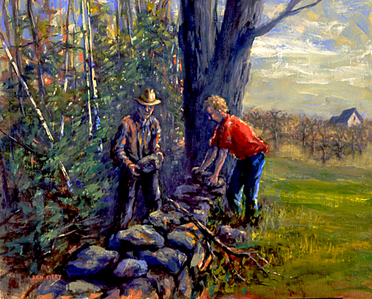“Mending Wall” is a twentieth-century poem that was published in 1914. Robert Frost had written when he was living in America. This poem was first published in a poetry collection in the North of Boston.
What is Mending Wall Poem About
Here the narrator is telling a story or his life. The narrator is a farmer who works on a farm. ‘Mending Wall’ was published along with ‘A Boy’s Will’ and ‘A Turf of Flowers’.
Mending Wall Critical Appreciation
After the publication of the poem, it gained attention from the critical world and many other critics criticized his work.
Mend Wall by Robert Frost Meaning
Here the title opines poet’s view of repairing a wall again and again. The wall is a symbol of ‘human disgrace’.
Poem Theme
The poem “Mending Wall” has several themes that have been explored. This poem explores the contradiction between humanity and life.
Even social boundaries are also highlighted in many parts. Because of social boundaries, humanity dies this is the central motive of the poet.

If the readers go to the Psychoanalytic theory then Sigmund Freud says about the id, ego, and superego. Here a man is creating a rule that can be ‘id’ and also can break the rules that should be ‘Super Ego’. Here, the narrator also speaks on that by the line,
“makes boundaries and he breaks boundaries”
This is not the end of this poem. Frost again comes with another theme of mischief. The poet mending the wall as a game but to the serious neighbours.
The Mending Wall Poem Summary & Analysis
The poem starts with the description of the narrator where he says there is a wall that the neighbours do not like. The wall helps the poet from getting swell by snow.
So, there is a seasonal explanation comes that says on the climate of America. The wall spill the upper boulders in the sun rays. It also makes a gap where two people can easily pass.
So, why the narrator is telling about the wall is not clear enough. The wall very helpful and it also saves the narrator from the hunter.
“I have come after them and made repair”
So when the narrator comes back to his house he always repairs it. In the lane there perhaps a rabbit is hiding to save from the ‘yelping dogs’.
The gaps that are made no one knows and that is why the rabbit is sitting in fear.
“But at spring mending-time we find them there.”
This line perhaps is dedicated to that rabbit that was staying there to save itself. So the wall is here working as a human boundary where no one will cross that and not enter into the personal life.
A nuclear family is important to lead a healthy life. And then the poet is letting his neighbours know ‘beyond the hills’ this is a metaphor that tries to signify the wall.

Then in a day, the narrator and his ‘so-called’ neighbour start walking on the lines and they set the walls between themselves again.
Everything is ok but there is a wall that is dividing themselves from each other. They are walking together but they can not be merged because of the wall that is standing and diverging from each other.
Perhaps the motive of the poem is to speak on the real fact. Every time neighbours stay close but never exchange the thought.
So, after a keen observation, it is clear that the narrator does not want the separation and creating a distance.
“Stay where you are until our backs are turned!”
That is the neighbour, who is saying to stay at a distance with each other. Maybe he wants to do it because of making his life private.
Then the poet is saying on his apple trees that never get across to the neighbour’s wall. Perhaps the neighbour can pick an apple to eat that would be a grand loss to the narrator.
Such a hypothetical approach is given in a normal sentiment. But this is s real criticism on the behaviour of the human.
“And eat the cones under his pines, I tell him.
He only says, ’Good fences make good neighbours.’
This is a thetical sentence that only makes a partition among the people. The neighbour is anticipating to maintain a distance.
Now the narrator is getting obsessed with his words and tells the reader the Spring plays a mischievous act with him. He is ironically saying,
“Why did they make good neighbors?”
When people do not feel free from the heart to utter then there is no need to besa neighbor. The neighbor is walking in and out though he does not know the relevance of this wall.
The neighbours went back to the darkness after finishing his speeches. He telling so well to the narrator that,
“Good fences make good neighbors.”
This is such a fancy sentence to him that does not mean anything relevant.
Literary Devices
Enjambment is the primary literary device that is being used in this poem. Enjambment is the continuation of thoughts to the next lines.
Techniques
“Mending Wall” is written in a blank verse that is also a poetical style of writing.
Then comes Alliteration, is the repetition of vowel sounds used in a single sentence one after another like,
“where they would”,
“good fences make good neighbors”.
Then comes Anaphora, which means the repetition of words in the starting of a line, one after another.
“And spills the upper boulders in the sun;
And makes gaps even two can pass abreast.”
Symbolism also can be found. Here “fences” is a symbolism that means a gap between two lives.
The metaphor also comes into the context. It is a figure of speech.
“And some are loaves and some so nearly balls”
Here, the narrator is comparing the stone blocks with balls.
Questions and answers
What does the poem Mending Wall by Robert Frost mean?
It means repairing a new wall.
What is the literary form of the poem Mending Wall by Robert Frost?
Blank verse is the form of writing the poem.
What is the conflict in the poem Mending Wall?
This is the conflict between humanity and the crucial mind.
What is the tone of the poem Mending Wall?
The tone of the poem is irony.